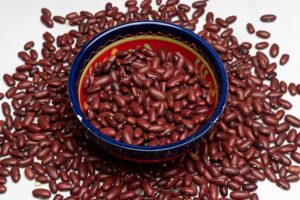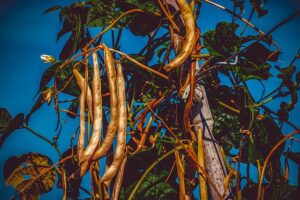Rajma cultivation in India has become a symbol of how traditional crops can create steady income while connecting us to our food roots. If you’ve ever enjoyed a plate of hot rajma chawal on a Sunday afternoon, you already understand why this humble bean holds such a special place in our kitchens and fields.
“Farming doesn’t just grow crops; it grows patience, purpose and pride.”
Introduction
Rajma, or kidney beans, are one of India’s most loved legumes. Apart from their taste and nutrition, they are also an important cash crop in several hill and plain regions.
Rajma plants are fairly easy to grow when the right soil, water, and climate are provided.

Here’s a quick table that covers the essential details for anyone interested in cultivating rajma in India.
| Aspect | Details |
|---|---|
| Botanical Name | Phaseolus vulgaris |
| Family | Fabaceae |
| Common Names | Rajma, Kidney Bean |
| Ideal Climate | Cool and frost-free during germination; warm and dry during maturity |
| Temperature Range | 18°C to 28°C |
| Soil Type | Well-drained loamy soil rich in organic matter |
| pH Range | 6.0 to 7.5 |
| Propagation | Direct seed sowing |
| Sowing Season | February–March (spring crop) or June–July (kharif crop) |
| Harvest Time | 100 to 120 days after sowing |
| Average Yield | 12–15 quintals per hectare |
History and Origin
Rajma originally came from South and Central America and reached India through trade routes centuries ago. Today, it’s deeply woven into North Indian cuisine and culture.
Himachal Pradesh, Jammu and Kashmir, Uttarakhand, and parts of Maharashtra are known for producing the best rajma beans, famous for their flavor and texture.
The name “rajma” itself is derived from the Hindi word rajmah, meaning royal bean—perhaps because it once graced the kitchens of kings and commoners alike.
Nutritional Value of Rajma
Rajma isn’t just delicious; it’s a powerhouse of nutrition. It’s packed with plant-based protein, complex carbohydrates, and essential minerals that support energy, muscle health, and digestion. Regular consumption of rajma helps maintain cholesterol levels and provides lasting satiety, making it a great food for both vegetarians and fitness enthusiasts.
| Nutrient | Amount (per 100 g boiled rajma) | Health Benefits |
|---|---|---|
| Calories | 140 kcal | Provides steady energy without spiking blood sugar |
| Protein | 5.7 g | Supports muscle repair and growth |
| Fat | 5.9 g | Contains healthy fats that support metabolism |
| Carbohydrates | 18 g | Supplies slow-releasing energy for daily activity |
| Fibre | 6–7 g (approx.) | Aids digestion and keeps you full for longer |
| Iron | 2–3 mg (approx.) | Helps in red blood cell formation and prevents fatigue |
| Calcium | 25–30 mg (approx.) | Supports bone strength |
| Magnesium | 35–40 mg (approx.) | Regulates muscle and nerve function |
| Potassium | 400 mg (approx.) | Maintains healthy blood pressure |
| Folate (Vitamin B9) | 90 µg (approx.) | Essential for cell repair and heart health |
Rajma Cultivation in India: Scope and Market Potential
If you’ve ever cooked a comforting bowl of rajma chawal on a Sunday afternoon, you know how deeply this dish is woven into our lives. But have you ever thought about growing those red beans yourself?
Rajma cultivation in India isn’t just for large-scale farmers anymore. With the right approach, even home gardeners can grow healthy, protein-rich beans right in their backyard or field.
Let’s look at how rajma farming works in India, from choosing the right soil to harvesting, and then understand its market potential for small and large growers.

1. Understanding Rajma and Its Importance
Rajma, or kidney bean, is one of the most loved pulses in Indian kitchens. It’s rich in protein, fibre, and essential minerals, making it a staple for vegetarian diets. For farmers, it’s also a profitable pulse crop because of strong market demand throughout the year.
Rajma is mainly grown in hilly regions like Jammu & Kashmir, Himachal Pradesh, and Uttarakhand, but it’s now expanding to states like Maharashtra, Madhya Pradesh, and Karnataka due to better irrigation and improved seed varieties.
2. Climate Requirements for Rajma Cultivation
Rajma grows best in cool to moderate temperatures.
- Ideal temperature: 18°C to 26°C
- Rainfall requirement: Around 60–120 cm annually
- Best season: Rabi and kharif seasons depending on region
Rajma is sensitive to frost and high humidity. It needs warm days and cool nights during its growth phase.
In northern India, sowing is usually done in February–March (summer crop) or June–July (monsoon crop). In hilly areas, farmers sow in May–June when the weather starts warming up.
3. Suitable Soil for Rajma Farming
Rajma prefers well-drained loamy or sandy-loam soil with good organic matter. Avoid clay-heavy soil that holds water, as kidney beans are prone to root rot in waterlogged conditions.
- Ideal soil pH: Between 6.0 and 7.5
- Tip: Add well-decomposed cow dung or compost before sowing to boost soil fertility.
If you’re growing rajma at home in pots, use a mix of garden soil + compost + sand in equal parts for good drainage.

4. Best Varieties of Rajma in India
Here are some popular and high-yielding rajma varieties grown across India:
| Variety | Characteristics | Suitable Regions |
|---|---|---|
| Jammu Rajma | Deep red, small size, famous for taste | Jammu & Kashmir |
| Chitra Rajma | Light-colored with red speckles | North India plains |
| PDR-14 | Early maturing, high yield | North and Central India |
| HUR-137 | Resistant to disease, bold seeds | Uttar Pradesh |
| VL Rajma-125 | Performs well in hills | Himachal Pradesh, Uttarakhand |
| Arka Komal (Pole variety) | Good for home gardens, tender pods | All regions |
When choosing a variety, consider your region’s climate, soil, and market demand.
5. Land Preparation and Sowing
For farm-level cultivation, start by ploughing the land 2–3 times to make it loose and aerated. Level the field to prevent waterlogging. Mix 8–10 tonnes of organic manure per hectare during the final ploughing.
Sowing time:
- North India plains: Late February to early March or June–July
- Hills: May–June
Seed rate: About 80–100 kg per hectare
Spacing: 30 cm between rows and 10 cm between plants
Depth: 3–5 cm deep
Always use disease-free certified seeds and treat them with a bio-fungicide like Trichoderma or Bavistin before sowing to prevent soil-borne diseases.

6. Watering and Irrigation Management
Rajma doesn’t tolerate standing water, so irrigation must be planned carefully.
- First irrigation: 20–25 days after sowing
- Second irrigation: During flowering stage
- Third irrigation: During pod formation
Too much water during flowering can reduce yield, so keep soil just moist. In home gardens, water only when the topsoil feels dry.
7. Fertilizer and Nutrient Management
Rajma is a legume crop, so it fixes nitrogen naturally through root nodules. Still, it needs balanced nutrients for higher yields.
- Basal dose: 20 kg nitrogen, 60 kg phosphorus, and 40 kg potash per hectare before sowing.
- Organic option: Apply vermicompost or cow dung along with biofertilizers like Rhizobium culture to improve soil health.
Avoid excessive nitrogen, as it promotes leaf growth instead of pod development.
8. Weed and Pest Control
Weeds compete for nutrients, especially in the early growth stage.
- Weeding: Two manual weedings at 20 and 40 days after sowing work well.
- Mulching: In small gardens, use dry leaves or straw to prevent weeds and retain moisture.
Common pests: Aphids, whiteflies, and pod borers.
Diseases: Rust, powdery mildew, and blight.
Use neem oil sprays or organic pesticides for home gardens. For large farms, follow integrated pest management practices recommended by local agriculture officers.
9. Harvesting and Post-Harvest Care
Rajma plants are ready to harvest in 90–120 days depending on variety and weather. Harvest when pods turn light brown and dry. Avoid harvesting too early as immature seeds will shrink while drying.
After harvest:
- Dry the pods in shade for 2–3 days.
- Shell the beans manually or with a thresher.
- Store in airtight containers or gunny bags in a cool, dry place.
For home gardeners, air-dried beans can be stored for months if kept moisture-free.

10. Average Yield and Economics
Yield varies with variety, climate, and management. On average, 1.2–1.8 tonnes per hectare is achievable. With good practices and disease management, high-yielding varieties can produce up to 2 tonnes per hectare.
Rajma prices in India usually range between ₹80–₹150 per kg, depending on variety and region. Farmers who grow rajma organically or in hilly regions often fetch a premium price due to quality and demand.
11. Scope and Market Potential
The demand for rajma is strong and steady, both domestically and internationally. North Indian states consume rajma regularly, and its popularity is now spreading across southern and western regions as well.
India also exports rajma to Nepal, UAE, and UK. The rise in plant-based diets worldwide has opened more export opportunities for Indian kidney beans.
For small farmers, rajma can be a profitable intercrop with maize or potato. For home gardeners, it’s a rewarding plant that adds nitrogen to the soil and provides nutritious produce for months.

12. Government Support and Future Outlook
The Indian government promotes pulse cultivation through various programs like the National Food Security Mission (NFSM), offering subsidies on quality seeds, irrigation equipment, and fertilizers.
With better irrigation access, disease-resistant varieties, and improved farming methods, the future of rajma cultivation in India looks promising.
Frequently Asked Questions1. Can we grow rajma at home in pots or containers? Yes, rajma can be grown easily in pots or containers. Use at least a 12-inch-deep pot with good drainage holes. Fill it with a mix of garden soil, compost, and sand. Keep the pot in a sunny spot and water when the topsoil feels dry. You can expect your first harvest in about three months. 2. What is the best time to sow rajma in India? The best time to sow rajma depends on the region and temperature. In North India, sowing is done from February to March for summer crops or June to July for monsoon crops. In hill regions, May to June works best when the soil starts warming up. Rajma needs mild weather and does not tolerate frost or heavy rains. 3. How much water does rajma need? Rajma plants need moderate watering. Overwatering can cause root rot, so keep the soil just moist. Generally, three irrigations are enough—first after 20–25 days of sowing, then during flowering, and finally when pods form. In pots, water only when the top layer feels dry to the touch. 4. How long does rajma take to mature and give yield? Most rajma varieties mature in 90 to 120 days after sowing, depending on the climate and variety. Early-maturing varieties are ready in about 85 days, while those grown in cooler regions may take longer. Plants are harvested when pods turn brown and dry for the best seed quality and yield. 5. How can farmers increase rajma yield? To increase yield, farmers should use certified seeds of improved varieties, follow proper spacing, and ensure good irrigation and weed control. Adding organic manure, using biofertilizers like Rhizobium culture, and managing pests with neem-based sprays can improve both yield and soil health. Regular field inspections help spot diseases early. |
Growing rajma in India is not complicated once you understand its basic needs—well-drained soil, moderate weather, and regular care. Whether you’re a small farmer looking to diversify your crops or a home gardener wanting to grow your own protein-rich beans, rajma fits beautifully into the Indian climate.
With proper care, it can reward you with high yields, good profits, and the satisfaction of harvesting one of India’s most loved foods.
